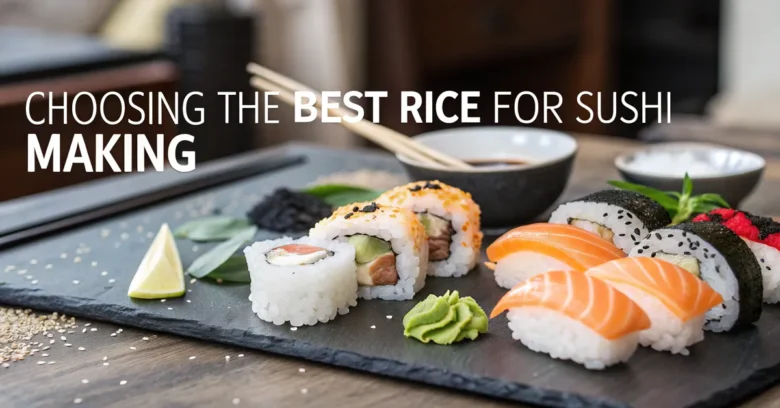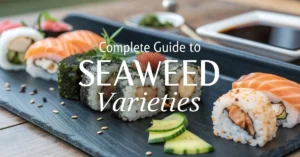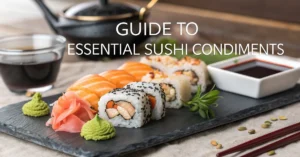The secret to truly great sushi isn’t just the fresh fish or the chef’s knife skills; it’s the rice. More than an accompaniment, sushi rice is the foundation upon which every perfect bite is built.
Choosing the right rice type can seem daunting, but don’t be. I’m here to guide you through the world of sushi rice, helping you pick the best grain for your homemade creations. Think of this as your ultimate guide to selecting rice types, ensuring your sushi is restaurant-quality every time.
Sushi Rice 101: What Makes It Special?
Before diving into specific rice types, it’s vital to understand what sets sushi rice apart. Unlike the long-grain varieties you might use for pilafs or the medium-grain ones suitable for risottos, sushi rice is a short-grain rice, typically Japonica varieties. It’s this short grain that gives sushi rice its unique characteristics:
- High Starch Content: Short-grain rice is packed with starch, which is mostly amylopectin. It is what gives cooked sushi rice its sticky texture.
- Absorbs Water Well: These rice types soak up water effectively during cooking, resulting in moist, plump grains.
- Pairs Beautifully with Vinegar: The slightly sweet and tangy flavor of sushi vinegar complements the rice’s natural taste and texture.
These characteristics are non-negotiable for excellent sushi. Trying to substitute with other rice types will leave you with a final product that’s either too dry, too mushy, or simply doesn’t hold its shape.
The Quest for Perfect Grains: Exploring Different Rice Types
Okay, let’s dive into the heart of the matter: the different rice types suitable for sushi making. While many options exist, a few stand out as clear winners.
1. The Gold Standard: Japonica Short-Grain Rice
When people talk about “sushi rice,” they almost always mean Japonica short-grain rice. This rice is available in most Asian grocery stores and some well-stocked supermarkets. Here’s why it’s so highly regarded:
- Texture: It cooks up fluffy yet sticky, making it easy to mold into various sushi shapes.
- Flavor: Japonica rice has a subtle sweetness that balances the savory flavors of fish and other sushi ingredients.
- Availability: It’s widely available, making it a convenient choice for most home cooks.
Within the Japonica family, several cultivars are considered top-tier for sushi:
- Koshihikari: Often hailed as the best sushi rice, Koshihikari boasts an exceptional balance of sweetness, stickiness, and aroma. It’s prized by sushi chefs worldwide.
- Hitomebore: A close relative of Koshihikari, Hitomebore offers a similar flavor profile and texture but is often more affordable. It is an excellent choice for everyday sushi making.
- Akitakomachi: Known for its elegant flavor and slightly firm texture, Akitakomachi is another popular option. Many sushi restaurants favor it for its consistent quality.
Expert Tip: Look for rice labeled “new crop” or “shinmai,” as it will be fresher and have a higher moisture content. New crop rice typically yields better results in terms of texture and flavor.
2. The Budget-Friendly Option: California-Grown Medium-Grain Rice
While short-grain Japonica rice is ideal, good quality California-grown medium-grain rice can be a serviceable alternative, especially if you’re on a budget or cannot find Japonica varieties readily available. This type of rice shares some similarities with short-grain rice but has a slightly longer grain.
- Acceptable Stickiness: When cooked properly, medium-grain rice can achieve a decent level of stickiness, allowing you to form sushi rolls and nigiri.
- Mild Flavor: The flavor is mild and doesn’t overpower the other ingredients in your sushi.
- Easy to Find: California-grown rice is widely available in most supermarkets.
Important Note: You may need to adjust the water ratio and cooking time when using medium-grain rice to achieve the desired texture. Start with slightly less water than you would use for short-grain rice and keep a close eye on it during cooking.
3. The Specialty Choice: Heirloom and Organic Varieties
For the adventurous home cook, exploring heirloom and organic sushi rice varieties can be a rewarding experience. These rice types often have unique flavor profiles and textures that can elevate your sushi to new heights.
- Heirloom Rice: These are traditional rice varieties that have been passed down through generations. They often have distinct characteristics that reflect their region of origin. For instance, some heirloom rice may have a nuttier flavor or a chewier texture.
- Organic Rice: Organic sushi rice is grown without the use of synthetic pesticides or fertilizers, making it a more sustainable and environmentally friendly choice.
Things to Consider: Heirloom and organic rice can be more expensive and harder to find than conventional sushi rice. However, the unique flavors and textures they offer may be worth the extra effort for special occasions.
Reading the Label: What to Look For
Navigating the rice aisle can be confusing, but knowing what to look for on the label can make the selection process easier. Here are some key things to keep in mind:
- Grain Length: Make sure the label clearly states “short-grain” or “medium-grain.”
- Rice Type: Look for Japonica varieties like Koshihikari, Hitomebore, or Akitakomachi.
- Origin: Rice grown in Japan or California is generally considered high-quality for sushi making.
- Milling Date: Check the milling date to ensure the rice is fresh. Ideally, choose rice that has been milled within the past year.
- Certifications: Look for certifications like USDA Organic or Non-GMO Project Verified if you prefer organic or non-GMO options.
Cooking Sushi Rice: Mastering the Basics
Choosing the right rice is only half the battle; cooking it properly is equally important. Here’s a step-by-step guide to cooking perfect sushi rice:
- Rinse the Rice: Place the rice in a fine-mesh sieve and rinse under cold water until the water runs clear. This removes excess starch and prevents the rice from becoming gummy.
- Cook the Rice: Combine the rinsed rice with water in a heavy-bottomed pot or rice cooker. The ideal water ratio is typically 1:1, but you may need to adjust it slightly depending on the rice type and your cooking method.
- Steam the Rice: Bring the water to a boil, then reduce the heat to low, cover the pot, and simmer for 15-20 minutes, or until all the water has been absorbed. If using a rice cooker, follow the manufacturer’s instructions.
- Rest the Rice: Once the rice is cooked, let it rest, covered, for 10 minutes to allow the steam to redistribute evenly.
- Season the Rice: While the rice is resting, prepare the sushi vinegar by combining rice vinegar, sugar, and salt in a small saucepan. Heat over low heat until the sugar and salt have dissolved.
- Mix the Rice: Transfer the cooked rice to a large wooden bowl (hangiri) or a non-reactive bowl. Gently drizzle the sushi vinegar over the rice, using a rice paddle to separate the grains and evenly distribute the vinegar.
- Cool the Rice: Fan the rice while mixing to help it cool down quickly and develop a glossy sheen. The ideal temperature for sushi rice is lukewarm.
Troubleshooting Common Issues
Even with the best rice and cooking techniques, things can sometimes go wrong. Here are some common issues and how to fix them:
- Rice is Too Sticky: You may have used too much water or not rinsed the rice thoroughly enough. Try reducing the water ratio or rinsing the rice for a longer period next time.
- Rice is Too Dry: You may have used too little water or overcooked the rice. Try increasing the water ratio or reducing the cooking time next time.
- Rice is Mushy: You may have overcooked the rice or not allowed it to rest properly. Reduce the cooking time and make sure to let the rice rest, covered, for 10 minutes after cooking.
- Rice Lacks Flavor: You may not have used enough sushi vinegar or the vinegar mixture may not have been properly balanced. Adjust the amount of vinegar to taste and make sure the sugar and salt are fully dissolved.
Storing Sushi Rice: Keeping It Fresh
Proper storage is key to maintaining the quality of your sushi rice. Here are some tips:
- Uncooked Rice: Store uncooked rice in an airtight container in a cool, dry place away from direct sunlight.
- Cooked Rice: Cooked sushi rice is best used immediately. If you have leftovers, store them in an airtight container in the refrigerator and use them within 24 hours.
- Reheating Rice: To reheat leftover sushi rice, microwave it briefly with a damp paper towel to prevent it from drying out.
Beyond the Basics: Experimenting with Flavors
Once you’ve mastered the art of cooking basic sushi rice, feel free to experiment with different flavors and additions. Here are some ideas:
- Infused Vinegar: Try infusing your sushi vinegar with ingredients like citrus zest, herbs, or spices for a unique flavor twist.
- Seasoned Rice: Add ingredients like sesame seeds, furikake (a Japanese seasoning blend), or finely chopped vegetables to the cooked rice for added flavor and texture.
- Colored Rice: Use natural food colorings like beet juice or spinach juice to create vibrantly colored sushi rice.
Sushi Rice Around the World: Regional Variations
Sushi rice isn’t just a single entity; it varies across different regions, each with its own unique characteristics.
- Japan: In Japan, Koshihikari rice is the undisputed king, prized for its exceptional quality and flavor.
- California: California-grown sushi rice is a popular alternative, known for its affordability and decent quality.
- Korea: Korean sushi rice, often called “chapssal,” is known for its extra-sticky texture, making it ideal for gimbap (Korean sushi rolls).
- Italy: Surprisingly, Italy is also a producer of sushi rice. Italian-grown Japonica rice is gaining popularity for its quality and sustainable farming practices.
Why You Should Nail Your Sushi Rice Game
Taking the time to select the right rice and cook it properly is an investment that pays off in several ways:
- Authentic Flavor: The right rice enhances the overall flavor profile of your sushi, creating a more authentic and satisfying experience.
- Perfect Texture: Properly cooked sushi rice has a delightful balance of fluffiness and stickiness, making it easy to mold and eat.
- Improved Presentation: Well-prepared sushi rice holds its shape beautifully, resulting in visually appealing sushi rolls and nigiri.
- Enhanced Enjoyment: Ultimately, using the right rice elevates the entire sushi-making and eating experience, making it more enjoyable for both you and your guests.
Is the Extra Effort Worth It? The Verdict on Choosing the Right Rice
So, is it worth the effort to be so particular about your rice? Absolutely. While you can technically make sushi with other types of rice, the results simply won’t compare.
Think of it like this: you wouldn’t use cheap ingredients to make a gourmet dish, would you? The same principle applies to sushi. The rice is the canvas upon which you create your culinary masterpiece.
By choosing the best rice, you’re setting yourself up for success and ensuring that your sushi is a true reflection of the art form.



